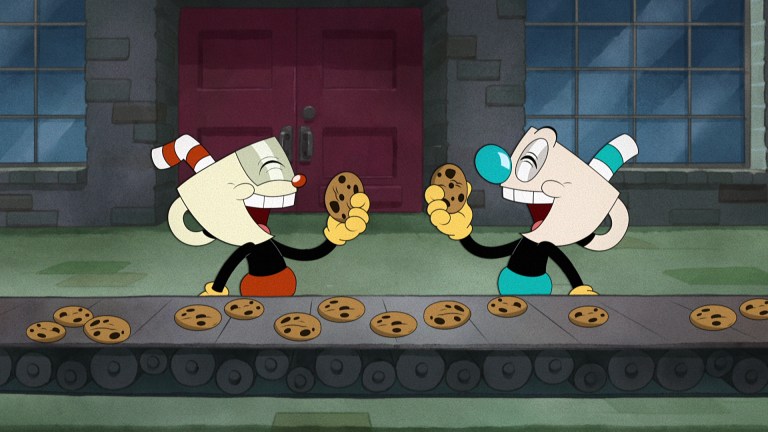The Cuphead Show! Feels Like It Wants to Be Played
Netflix's The Cuphead Show! brings a stylish video game back to its old-timey television inspiration with mixed results.

This article contains no spoilers for The Cuphead Show.
When independent developer Studio MDHR released Cuphead in 2017, gamers all over the world were astounded by the daring art style and fluid gameplay the title offered. Controlling the titular Cuphead and his brother Mugman, players became entranced in a world where they could control a 1930s cartoon that doubled as a video game.
Many of the trademark animation techniques of the decade are imitated in the game, namely the rubber hose style. Boss fights have rich historical backgrounds rooted in fun and obtuse trivia from the time period and other lore in gaming. (Cuphead Wiki gives you some amazing facts and tidbits about each character in the game.)
This is the type of creative mettle that AAA studios have unfortunately become too complacent to replicate, instead making games that repeat the same concepts and styles over and over again. Indie teams have come storming into the rescue and saved everyone. Their efforts have become so appreciated and mainstream that streaming services like Netflix no longer fear giving the green light to an on-screen adaptation for gems like Cuphead.
It doesn’t take too much marketing ingenuity to make such a decision, though. As was already stated, the game is known for its rigorously tight emulation of animation from nearly a century ago. Taking the game and returning it to its medium of inspiration seems all too obvious. This isn’t even the first time that the game has been used as a cash cow to capitalize on its now-iconic characters, as fast food chain Arby’s introduced toys based on the main characters in 2020.
So how closely does the Netflix series maintain the genuine feel of excitement that gamers experienced when they entered the Inkwell Isles some five years ago? It’s a tough task for the producers of the show, as it could easily feel like a step backwards from what the game offers. There is already a great story in tact in the latter, and controlling the course of action in a video game is much more captivating than staring at the TV screen and simply watching the entertainment unfold.
The initial verdict many are going to feel when they tune in for the first few episodes is that the adaptation feels like a run-of-the-mill buddy cartoon. Cuphead and Mugman serve as your typical brother duo. The main character is willing to take risks, makes rash decisions, and spurs most of the slapstick humor in the show. Brother Mugman is the straight man, the one who plays off of the nonsense that Cuphead introduces into their lives.
You never get these characterizations in the video game, so this is new territory in the show. In many ways, protagonists that are left more ambiguous for the audience are the ones who feel more intimate. The person playing the game can parlay any of their own emotions and personality traits onto the characters, molding Cuphead into whatever character they want him to be. The show takes some of these liberties away, making him more of a SpongeBob-esque creation.
The voice acting of Cuphead (Tru Valentino) and Mugman (Frank Todaro) is actually quite commendable. They play off of each other well, and their high and low-pitched voices are aesthetically pleasing to the ear. The problem is that it kind of feels like these two characters may have been better left off as silent players in their own universe.
One of the classics that the game pays homage to is Tom and Jerry, an animated series in which the famous cat and mouse are usually muted. Their actions speak for themselves, and viewers are still in love with the legendary pairing over 80 years later. If you were to add major speaking roles for these characters, it would take something away from the aura of the program. The comedic value in their actions would be watered down. In many ways, this feels like somewhat of the same scenario for Cuphead and Mugman. Adding a tangible voice to their actions feels a little forced and out of place.
These issues are exacerbated if you are a fan of the video game first. The brilliant graphical style of the franchise is kept perfectly in-tact, though, and will pique the interest of newcomers who have never even heard of the video game. Young children in particular should get a great kick out of some of the shenanigans that the two brothers get themselves into throughout the show’s debut season, as they are more in-tune with contemporary cartoon storytelling.
The story switches between an issue-of-the-week type of plot (Cuphead and Mugman lose their handles on their backs), and episodes that tie in more to the video game’s overarching threads (Cuphead owes his soul to the devil). The second type of plots bring in other beloved characters from the game, (Ribby and Croaks, and King Dice are two of the best ones).
For the The Cuphead Show! to truly become something special in future seasons, it will need to stop straddling the line between the two. Children’s cartoons aren’t meant to tell connected stories, as the singular episode model works better for their attention spans. Themes can stay intact, but plots should change episodically. Adults would enjoy season-long arcs better than the former, but I’m not sure this audience is who the writers are aiming for.
The show then turns into a potpourri of dynamic visual flare with lukewarm humor and characterizations. The addition of voice acting is nicely done, but does not fully capture the authenticity of the era that the video game was inspired by. Expect to enjoy this one as a casual watch with your little tykes, but get an itch to immediately go back to your console of choice and fire up the genuine article after binging the TV series.
All episodes of The Cuphead Show! premiere Friday, Feb. 18 on Netflix.
